10c notes of the Estado de Sonora
(This section is the result of research by Robert Perigoe. The information originally appeared in the March 2018 issue of the Journal of the U. S. Mexican Numismatic Association).
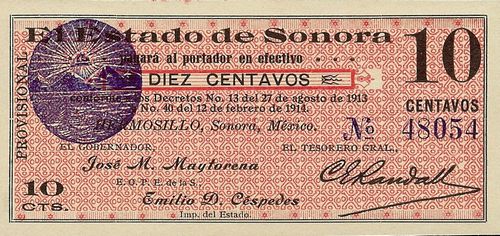
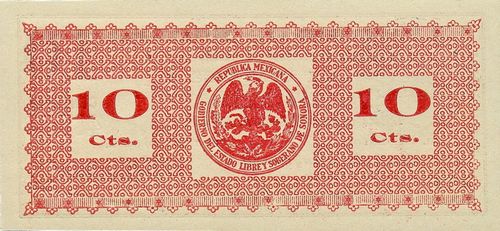
M3812a 10c El Estado de Sonora
Position A - Mountain seal 1
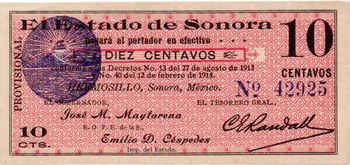
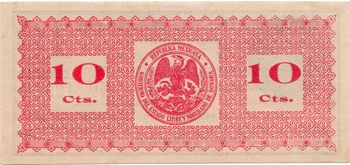
Position B - Mountain seal 5
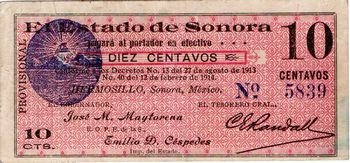
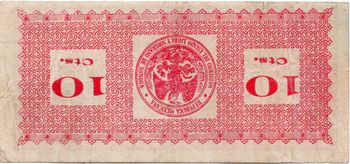
Position C - Mountain seal 2
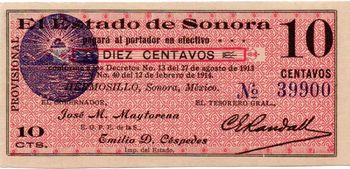
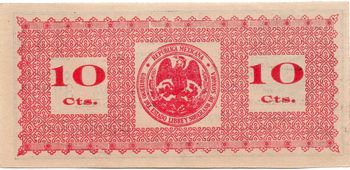
Position D - Mountain seal 4
This issue marked the final appearance of the mountain seals that had previously been utilized on the pesos series. Below are the five different seals as they appeared in the contemporary revenue stamps. The printing on the revenue stamps is complicated by obscuring black printing of words and borders, and somewhat further by intruding coloured backgrounds which can be easily ignored. The good news in the illustration is that the printing of the seals on the stamps is much clearer than on the currency.
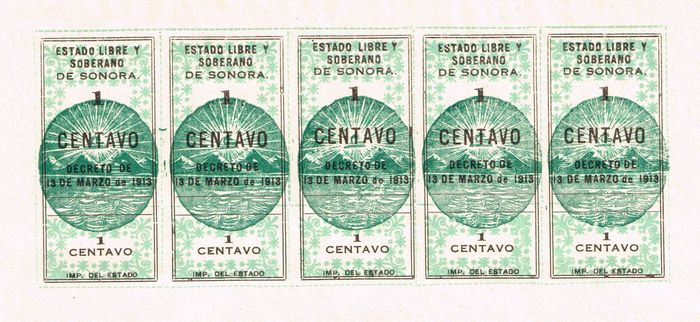
The distinguishing features of the five Types follow (the illustrations are all from the one peso notes).
| Type 1 | 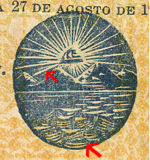 |
Thick ray leading from the bottom of the Liberty Cap and pointing to the leftmost mountain |
| Type 2 | 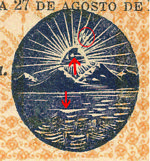 |
Spots in the two large rays to the right of the vertical ray at the centre Long ripple one third of the way down and centre-left in the water The middle mark on the Liberty Cap is circular and joined to the dash-shaped mark at the right. |
| Type 3 | 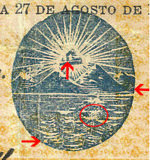 |
An enclosed colourless circle in the water near the outer edge at 7 o’clock Diagonal scratches in the water, one third of the way down and central right Diagonal lines on the lower right of the rightmost mountain On the Liberty Cap, the left and middle marks are almost rectangular and at the same level. |
| Type 4 | 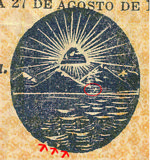 |
A circular notch in the water at the outer edge at 7 o’clock Two other colourless spots in line with this notch to the right and downward At least one colourless spot in the horizontal lines above the shoreline. |
| Type 5 | 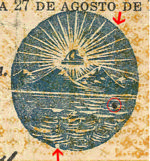 |
A circular notch in the outer edge, or an enclosed colourless circle by the outer edge, of the water between 6 and 7 o’clock A vertical scratch from 1:30 towards 5:00 (The dark spot circled in the illustration is not part of the seal, but a stray spot from the black printing.) |
In this issue, mountain seal Type 1 appears in Position A (Top), Type 5 in Position B (Upper Middle),Type 2 in Position C (Lower Middle), and Type 4 in Position D (Bottom). Research suggests an initial setting of 25 print runs of 100 sheets, followed by a second setting of 20 runs of 500 sheets. Thus
0001 0002 0003 … 0100
0101 0102 0103 … 0200
0201 0202 0203 … 0300
0301 0302 0303 … 0400
0401 0402 0403 … 0500
0501 0502 0503 … 0600
0601 0602 0603 … 0700
0701 0702 0703 … 0800
to
9601 9602 9603 … 9700
9701 9702 9703 … 9800
9801 9802 9803 … 9900
9901 9902 9903 ..10000
and then
10001 10002 10003 … 10500
10501 10502 10503 … 11000
11001 11002 11003 … 11500
11501 11502 11503 … 11200
to
48001 48002 48003 … 48500
48501 48502 48503 … 49000
49001 49002 49003 … 49500
49501 49502 49503 ... 50000
Print Positions
There are several other ways to identify the four positions, and if remainders or replacement notes are ever encountered, they are the only choice.
Signature
The Randall signature is positioned differently relative to the corner on each position, in the same print positions as occurred in the five centavos notes, thus. Examination of the space between the signature and the two frame lines is the key. A rule of thumb is to say the signature clears the frame line if the space between the two would accommodate another line of the same thickness, and to say the signature almost touches the frame line when it may be too close to call, but there is certainly not enough room to squeeze in another line between them. In Position A the signature clears both frames. In Position B it almost touches both frames. In Position C it almost touches the right frame, but clears the bottom. In Position D it clears the right frame but almost touches the bottom.
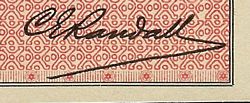 |
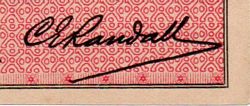 |
|
| Position A | Position B | |
 |
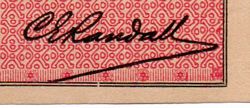 |
|
| Position C | Position D |
Background
The kind of X and circle background printing encountered on the reverse of the five centavos note is found on both sides of this note. In fact, the reverse of the ten centavos note has the same characteristics as the reverse of the five centavos, and the print position can be determined in the same way. Only the ink colour is different.
The front of the ten centavos provides additional positional identification clues. Once again, all X and circles are type B unless indicated below.
Position A displays no cross aberrations on its back. On the front, on the other hand, the top row is a typesetter’s dream, using three of the four types of background crosses (missing Type L). Identified types are highlighted with green dots in the illustration below. They are very difficult to identify at the left of the note. On the right, partially obscured by the large number 10, there are four of the routine type B crosses. But peeking over the large Sonora there are six of the type T crosses. Perhaps the design elements were spilled and then inserted randomly. This may appear to be bizarre, but it pales in comparison to the machinations that followed in many stamp issues and those who study them.

On the front of Position B, cross Type R can be found in the third row from the top, at the far right.
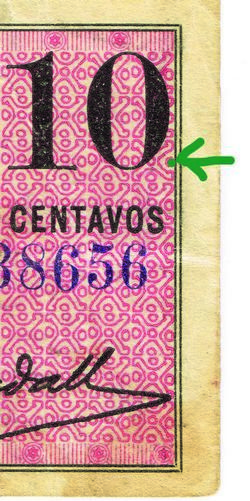
On the front of Position C, cross type R appears in the sixth row from the top and sixth column from the right.
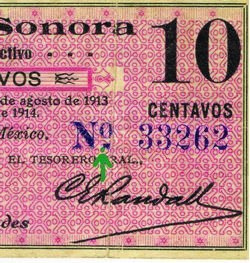
On the front of Position D, cross type R can be found in the sixth row down and fifth column from the left, if the mountain seal allows it to be seen.
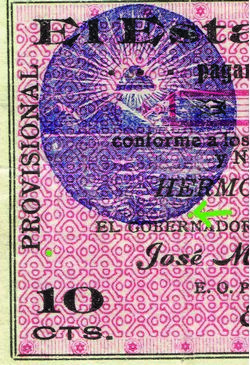
In summary, the four positions can be distinguished thus:
| Position | Mountain Seal Type |
Randall Signature | Type B Background crosses on front |
Type B Background crosses on reverse |
| A | 1 | Easily clears both frames | Top row is RRBTTTTTRTTTTTTTTTBB |
No exception |
| B | 5 | Almost touches both frames | One exception, 3rd row from top, at the far right is Type R | One exception, 3rd row from top, 2nd from right is Type L |
| C | 2 | Almost touches right frame | One exception, 6th row from top, 6th from right is Type R | One exception, top row, 2nd from left is Type R |
| D | 4 | Almost touches bottom frame | One exception, 6th row from top, 5th from left is Type R | One exception, bottom row, 7th from right is Type R |
